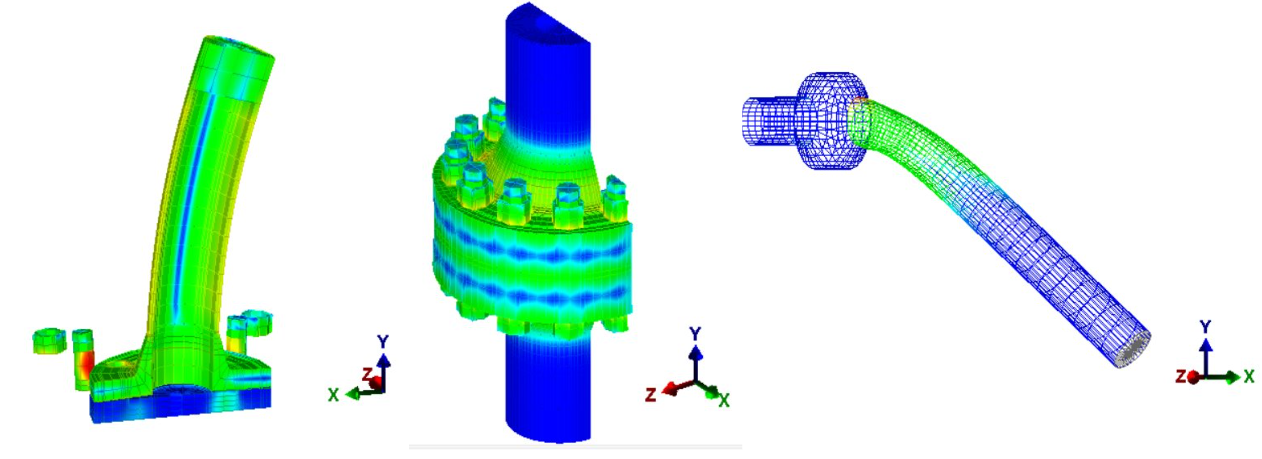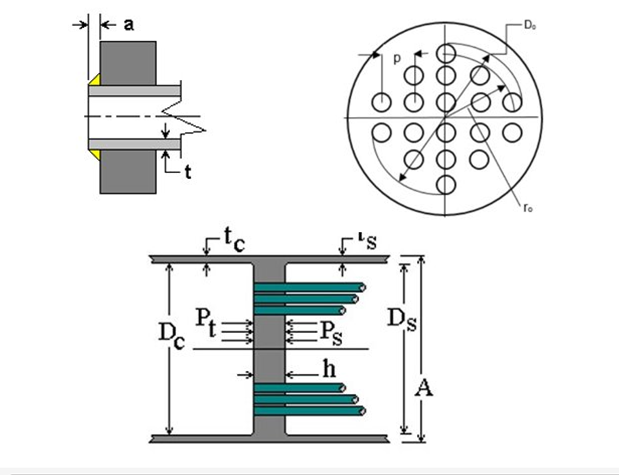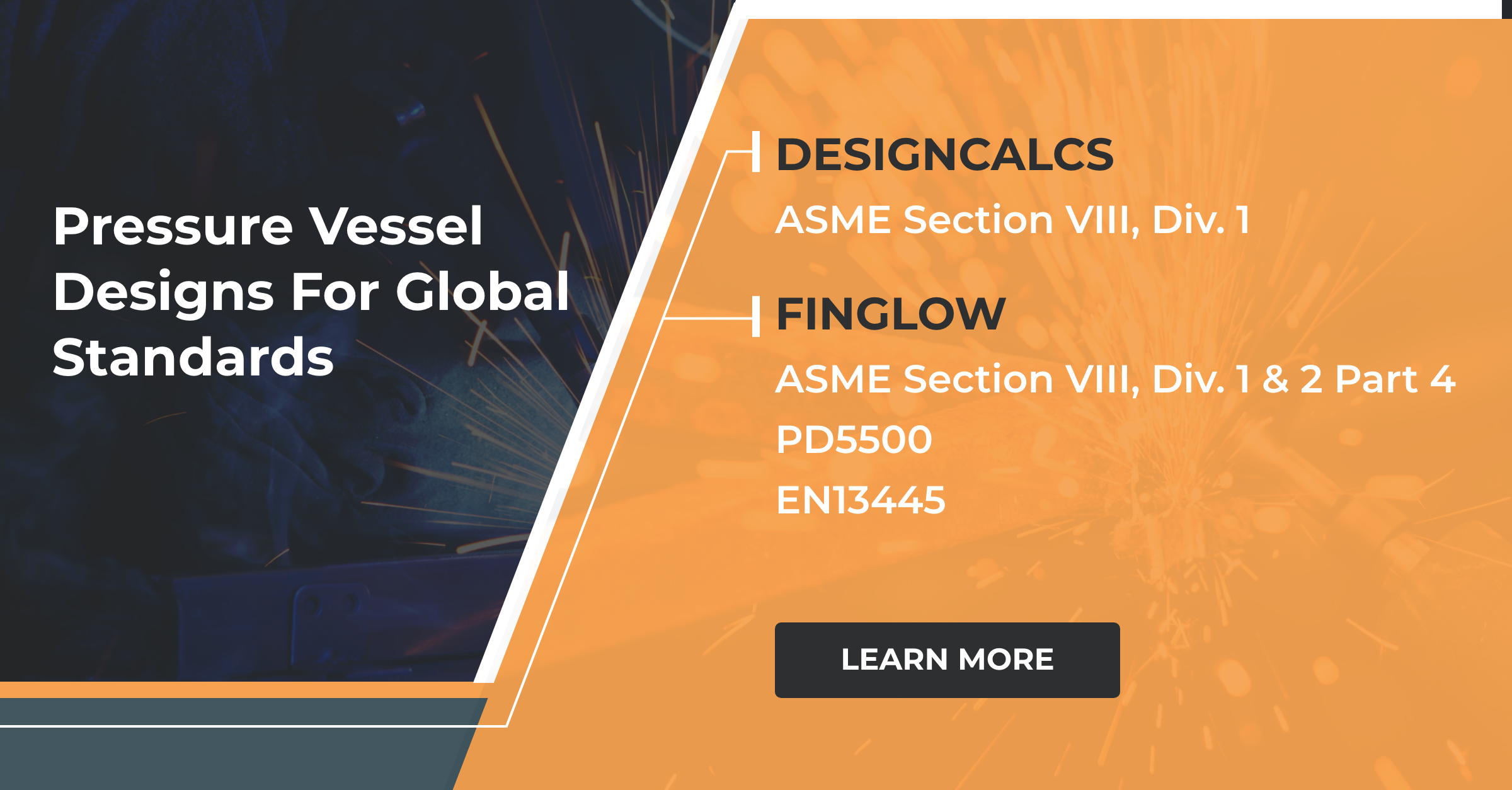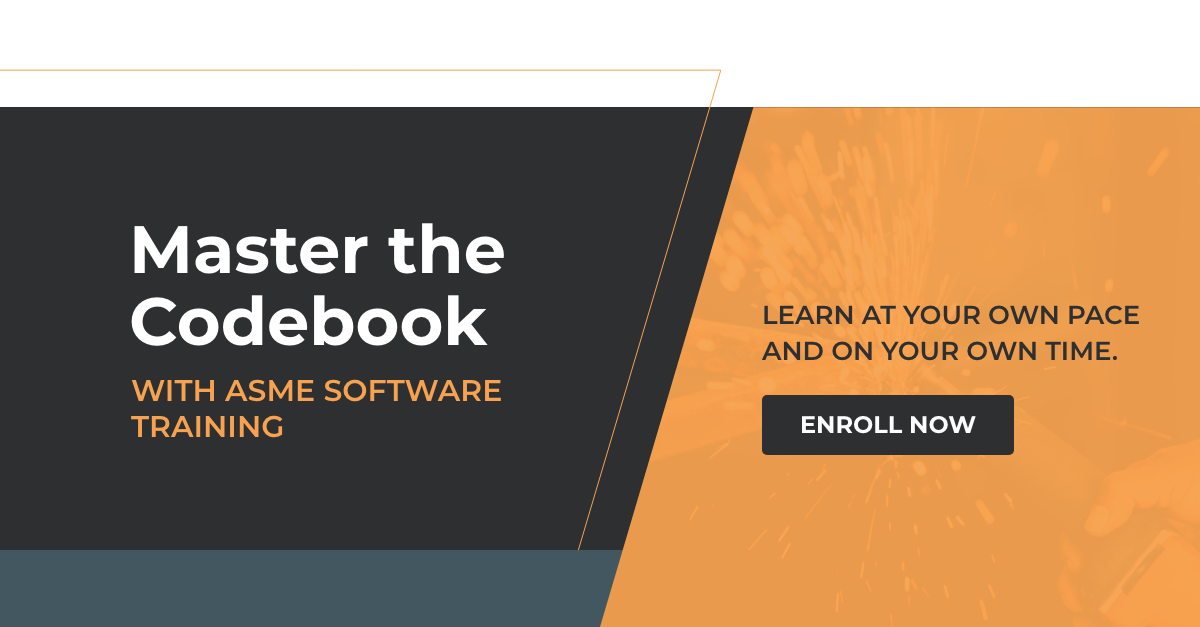Pressure vessels are subject to specific manufacturing codes in many countries, and in the United States, the go-to code is the Boiler and Pressure Vessel Code (BPVC) from the American Society of Mechanical Engineers (ASME). This code ensures the safe and efficient design and construction of pressure vessels.
To provide valuable assistance to professionals in the industry, we have created a comprehensive set of guides, FAQs, and resources that address the latest code updates for 2023. These resources are specifically designed to help ensure the safe and cost-effective delivery of pressure equipment.
|
TABLE OF CONTENTS: (Click on a link to jump directly to a section)
CERTIFYING ENGINEER REQUIREMENTSBig Code Shifts for Professional Engineers
DESIGN METHOD CHANGES IN D1 & D2Appendix A Configuration Equivalents
CODES OUTSIDE OF THE U.S.
SECTION IXSupplemental and Nonessential Variables
ACCLIMATING TO CODE UPDATESPV Design & Welding Solutions |
Note: The following guide is updated as of the 2023 code changes to ASME, PD 5500, and EN. For a summary, watch this webinar.
For B31 piping updates, visit our blogs on FEA Insights.
CERTIFYING ENGINEER REQUIREMENTS
Big Code Shifts for Professional Engineers
One of the biggest changes we've seen in 2023 involves the need for a professional or certifying engineer (PE) for ASME Section VIII, Div 2 vessels. On both the engineer and the manufacturer side, these responsibilities have been reduced quite a bit.
Here's what changed:
- In the 2021 edition of Div 2, paragraph 2.2.1 listed a requirement for the User's Design Specification (UDS) to be certified by a PE for Class 1 vessels (fatigue analysis) and for ALL Class 2 vessels.
- In the 2023 edition of Div 2, the same paragraph now requires a PE when fatigue analysis is required (no reference to vessel class).
- A similar removal of the PE requirement took place in the Manufacturer's Design Report (MDR) and now it is only required if Design-By-Analysis (DBA) is used, regardless of the vessel class.
- Additionally, Design-By-Rule (part 4) no longer requires a PE except when a DBA is required, regardless of the Class. So when creating a DBR for a Part 4, Div 2 vessel, a PE is not a requirement and is not needed to certify the MDR.
DESIGN METHOD CHANGES IN D1 & D2
UHX
In the latest update, UHX is significantly more reduced than it used to be. For example, equations are no longer in UHX, and design requirements now solely reside in 4.18 under ASME Section VIII, Div 2. However, inspection and testing requirements still remain in UHX.
Additionally, the code changed slightly for designing Thin-Walled EJ (bellows) where common design requirements were stated between Appendix 26 and 4.19; now, they are just in 4.19.
This doesn't necessarily mean that users have to design heat exchangers in Div 2. This change just means that you must reference the rules in Div 2 even for a Div 1 vessel.
In a nutshell, common design methods are now in Div 2.
Tubesheets
Tubesheet design methods have changed slightly, mainly focusing on new requirements for integral channel cones. For example:
- Integral Channel Cones have been added to 4.18.
- Some simplifications in the integral channel shape coefficients have been removed.
- The cone option now allows a third integral channel option but is limited to no straight and concentric.
In a nutshell, the most common shape coefficient factors (Lambda, Delta, Omega, and Zeta) are more complicated equations to follow than previously. Further, lambdas and deltas are now based on mean diameter instead of the inside diameter. As far as the cone options go, these are now explicit code options. Previously, users could satisfy this with UG-22 and "good engineering practices."
Flexible Shell Element
While flexible shell element (FSE) is not limited to heat exchangers, it's common to design FSEs from shells and tubes on heat exchangers.
In mandatory Appendix 5 (Div 2, Paragraph 4.20), there was a change in the screening criteria on whether users had to do a cylinder calculation for the outer straight flange (see image below for reference).

Previously, in Appendix 5 (paragraph 4.20, Div 2), the limit that was set (before prompting users to complete the calculation), was the total length in the outer straight flange from knuckle to knuckle. Now, the limit has been updated to be twice the amount that was set before, so users are less likely to have to satisfy that calculation.
Additionally, users can now perform a numerical or FEA analysis instead of the cylinder calculation, which is easy to do with automated FEA.
Related Article: How to Determine Maximum Allowable Stresses on Flexible Shell Elements
Tube-to-Tubesheet Joints (D1)
Regarding tube-to-tubesheet design and welding, these rules are now moved from Appendix A to UW-20 (or UW-20.4). In actuality, they were removed completely. Previously, these designs were not mandatory since lettered appendices are not mandatory and numbered are. Since they have been moved under D1, they are now required.
This is important for those who design expanded-only or welded and expanded joints.
With the updated rules, you can calculate the welds by considering the expanded tube length in the lending strength at the joint (UW-20.4).
For the weld configuration, use UW-20.4 (formerly Appendix A) calculations. UW-20.4 configurations have changed their denotation over the years. In 2021, (f) and (g) swapped and the option to pick (b-1) was removed. DesignCalcs now shows 2023 configurations regardless of the year selected for the vessel. The table below shows the 2023 equivalents to the older years.
Rated Flanges & ASCE 7
The 2023 code edition for rated flanges now points to the 2020 edition for those requirements, specifically for ASME B16.5 and B16.47 like Tables U-3 under Division 1 and Table 1.1 under Division 2.
Additionally, the 2023 editions of ASME Div 1 and Div 2 now point to the 2022 edition of ASCE 7 rather than 2016. This is important for those needing to determine their seismic and tornado loadings.
CODES OUTSIDE OF THE U.S.
European ASME BPV Materials
Typically, ASME updates its materials in a significant way, adding some, and deleting others, and this year is no different.
In Div 1 and 2 of Section VIII, several materials have been added and removed to UCS-23, UHA-23, UNF-23.3, and UNF-23.5.
But the most notable updates this year occur in Section II, Part D:
- Additions and deletions to the stress, yield, and ultimate tables
- TE-1 Group 2 added: 27Cr – 7.5Ni - 4.5Mo - Co - N
- Elastic Modulus values assigned for C19200, C37700, C46500, C62300, C72200 and C96200
PD 5500
Several updates have been made regarding reinforcement by increased wall thickness, pads, or studded outlets (in other words, not nozzles). Specifically, the pressure loaded area calculation for Ap has been adjusted to now include the region inside the thickened part of the shell or compensation pad, but if the opening is fitted with an internal blind flange, then this area can now be omitted. This update is less conservative than what was stated in the 2021 edition.
For bolted circular flat ends, the equation for minimum required thickness has been changed to use the maximum value from the bolting up and operating conditions.
Regarding flanges, Section 3.8.3 has been updated so that if a hub slope exceeds 1:4, then the limitation of 1.5t applies regarding the proximity of the weld to the small end of the hub.
Additionally, the equation for the pressure stress in the shell at the edge of an attachment or pad has been added, and the clarification that the thickness used in the calculation doesn’t include pad thickness. So, if someone is designing a pad that lies at the edge of a nozzle or an attachment, the code now directs designers to use the shell thickness when determining the pressure stress calculation.
EN 13445
Several material changes affect the 2023 version of EN 13445, including:
- In Table A.1, The Grouping System for Steels, a new group for Duplex has been added along with the addition of specific nickel content for other Duplex groups.
- Mainly editorial changes, but the WPQR test procedures in Clause 8.3 have been refined.
- The changes to Part 3 are currently out for formal vote and will probably be ready for Q3 in 2024.
SECTION IX
Supplemental and Nonessential Variables
New requirements for supplemental and nonessential variables mainly take up the update to the ASME Section IX code changes.
- In QW-409.4 and QW-410.9, the requirements for supplemental essential variables have been removed, while the nonessential variable still applies for changing AC to DC or vice versa as well as electrode polarity requirements.
- For better clarity, they have replaced those codes with new requirements for specific processes pertaining to supplemental variables in QW-409.30 and QW-410.87.
- This creates a clear difference when a variable is a supplementary essential variable and when it is a nonessential variable.
- You are now allowed to exclude certain supplemental essential variables when you have specific P number combinations of your base metals if you're using some solution heat treatments or applying some post-volt heat treatments to the processes or base metals you're working with.
- In QW-409.32 new updates to your GMAW and FCAW processes have been added that basically state the transfer mode must be specified and change of transfer mode is now a nonessential variable.
- And lastly, a new article has been added for additive manufacturing rules and additive manufacturing materials. In Article 6, titled "Material Manufacturing Using Wire Additive Welding," several filler metals have been added to the base metals so you can properly fill out welding documentation for the additive manufacturing processes that were just added in QW-422.
ACCLIMATING TO CODE UPDATES
PV Design & Welding Solutions
When the latest edition of the code comes up, it can feel natural to panic a little as professionals and companies do not want their equipment to be halted by production shutdowns or redesigns.
Regarding several of these code updates, code assistance software like DesignCalcs and Finglow for pressure equipment design and ProWrite for welding processes and documentation help companies maintain their pressure equipment without wasting extra time or money. Our team of developers, who are actively involved in various ASME code committees, have diligently updated our databases to reflect the recent changes impacting pressure vessel designs, heat exchangers, tubesheets, material databases, and more. This proactive approach guarantees that models can be swiftly and effortlessly validated against the 2023 code edition updates and previous versions, reinforcing the maintenance of pressure equipment and minimizing the risks associated with equipment failure.
FEA & Piping Solutions
Additionally, finite element analysis (FEA) and pipe stress software play a crucial role in the design and analysis of pressure equipment, such as heat exchangers and tubesheets. Our partners at Paulin Research Group have several essential tools that help users navigate through the ASME codes, specifically ASME Section VIII, Div 2 (Part 4 and 5), and B31.1 and B31.3 piping codes.

Powered by FEA, PRG software allows engineers to perform numerical analysis and simulate the behavior of complex structures in minutes, providing valuable insights into the structural integrity and performance of the equipment.
With automated FEA capabilities, designers can easily calculate stresses and deformations, ensuring compliance with the updated code requirements. Additionally, pipe stress software enables engineers to accurately evaluate the behavior of pipe systems under various operating conditions, such as thermal expansion, pressure, and external loads.
By considering factors like mean diameter and cone options, users can optimize the design and ensure the safety and reliability of the piping system. With the advancements in FEA and pipe stress software, professionals can confidently navigate the code updates, validate their designs, and minimize the risks associated with equipment failure.
Appendix 47 Compliance Training
CEI's ThinkTank Academy is an exclusive online learning platform catered to users of ProWrite, DesignCalcs, Finglow, and several FEA software solutions from Paulin Research Group.
Subscribers gain access to a wide range of courses that offer on-demand video training from our highly skilled and certified engineers. They also have the flexibility to access online resources and certifications at their own pace, allowing for convenient and efficient learning.
What sets ThinkTank Academy apart is that subscribers not only have access to curriculum experts but also to software designers for any additional support or questions they may have.
While our courses are available to anyone, the ThinkTank Academy is specifically designed to meet the needs of foremen, Certified Welding Inspectors (CWIs), Quality Assurance (QA) and Quality Control (QC) managers, welding engineers, designers, Professional Engineers (PEs), and FEA engineers.
So, when you need software to help you through the latest 2023 code edition updates, you can count on CEI and Paulin Research Group. And when you need an easy way to navigate the software that makes design and analysis easy, you can count on the ThinkTank Academy.







Leave a Comment